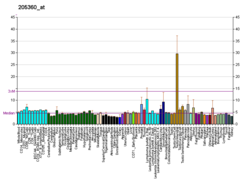Protein-coding gene in the species Homo sapiens
| PFDN4 |
|---|
|
| Identifiers |
|---|
| Aliases | PFDN4, C1, PFD4, prefoldin subunit 4 |
|---|
| External IDs | OMIM: 604898; MGI: 1923512; HomoloGene: 37645; GeneCards: PFDN4; OMA:PFDN4 - orthologs |
|---|
| Gene location (Human) |
|---|
 | | Chr. | Chromosome 20 (human)[1] |
|---|
| | Band | 20q13.2 | Start | 54,208,087 bp[1] |
|---|
| End | 54,228,052 bp[1] |
|---|
|
| Gene location (Mouse) |
|---|
 | | Chr. | Chromosome 2 (mouse)[2] |
|---|
| | Band | 2 H3|2 91.91 cM | Start | 170,338,348 bp[2] |
|---|
| End | 170,361,043 bp[2] |
|---|
|
| RNA expression pattern |
|---|
| Bgee | | Human | Mouse (ortholog) |
|---|
| Top expressed in | - oocyte
- ganglionic eminence
- Achilles tendon
- frontal pole
- Brodmann area 10
- paraflocculus of cerebellum
- superficial temporal artery
- ventricular zone
- palpebral conjunctiva
- secondary oocyte
|
| | Top expressed in | - zygote
- primary oocyte
- secondary oocyte
- medial ganglionic eminence
- hand
- epiblast
- facial motor nucleus
- ventricular zone
- embryo
- superior cervical ganglion
|
| | More reference expression data |
|
|---|
| BioGPS | 

 | | More reference expression data |
|
|---|
|
| Gene ontology |
|---|
| Molecular function | - chaperone binding
- unfolded protein binding
- protein binding
| | Cellular component | - cytosol
- nucleus
- cytoplasm
- prefoldin complex
- mitochondrion
| | Biological process | | | Sources:Amigo / QuickGO |
|
| Orthologs |
|---|
| Species | Human | Mouse |
|---|
| Entrez | | |
|---|
| Ensembl | | |
|---|
| UniProt | | |
|---|
| RefSeq (mRNA) | | |
|---|
NM_001013369
NM_001110152
NM_001199902 |
|
|---|
| RefSeq (protein) | | |
|---|
| Location (UCSC) | Chr 20: 54.21 – 54.23 Mb | Chr 2: 170.34 – 170.36 Mb |
|---|
| PubMed search | [3] | [4] |
|---|
|
| Wikidata |
| View/Edit Human | View/Edit Mouse |
|
Prefoldin subunit 4 is a protein that in humans is encoded by the PFDN4 gene.[5][6][7]
Function
This gene encodes a member of the prefoldin beta subunit family. The encoded protein is one of six subunits of prefoldin, a molecular chaperone complex that binds and stabilizes newly synthesized polypeptides, thereby allowing them to fold correctly. The complex, consisting of two alpha and four beta subunits, forms a double beta barrel assembly with six protruding coiled-coils.[7]
References
- ^ a b c GRCh38: Ensembl release 89: ENSG00000101132 – Ensembl, May 2017
- ^ a b c GRCm38: Ensembl release 89: ENSMUSG00000052033 – Ensembl, May 2017
- ^ "Human PubMed Reference:". National Center for Biotechnology Information, U.S. National Library of Medicine.
- ^ "Mouse PubMed Reference:". National Center for Biotechnology Information, U.S. National Library of Medicine.
- ^ Vainberg IE, Lewis SA, Rommelaere H, Ampe C, Vandekerckhove J, Klein HL, Cowan NJ (May 1998). "Prefoldin, a chaperone that delivers unfolded proteins to cytosolic chaperonin". Cell. 93 (5): 863–73. doi:10.1016/s0092-8674(00)81446-4. PMID 9630229. S2CID 16011829.
- ^ Iijima M, Kano Y, Nohno T, Namba M (Apr 1996). "Cloning of cDNA with possible transcription factor activity at the G1-S phase transition in human fibroblast cell lines". Acta Medica Okayama. 50 (2): 73–7. PMID 8744932.
- ^ a b Coraboeuf E, Deroubaix E, Hoerter J (May 1976). "Control of ionic permeabilities in normal and ischemic heart". Circulation Research. 38 (5 Suppl 1): I92–8. PMID 5203.
Further reading
- Hartl FU, Hayer-Hartl M (Mar 2002). "Molecular chaperones in the cytosol: from nascent chain to folded protein". Science. 295 (5561): 1852–8. Bibcode:2002Sci...295.1852H. doi:10.1126/science.1068408. PMID 11884745. S2CID 15037639.
- Hansen WJ, Cowan NJ, Welch WJ (Apr 1999). "Prefoldin-nascent chain complexes in the folding of cytoskeletal proteins". The Journal of Cell Biology. 145 (2): 265–77. doi:10.1083/jcb.145.2.265. PMC 2133115. PMID 10209023.
- Cowan NJ, Lewis SA (Nov 1999). "A chaperone with a hydrophilic surface". Nature Structural Biology. 6 (11): 990–1. doi:10.1038/14870. PMID 10542082. S2CID 22081346.
- Collins C, Volik S, Kowbel D, Ginzinger D, Ylstra B, Cloutier T, Hawkins T, Predki P, Martin C, Wernick M, Kuo WL, Alberts A, Gray JW (Jun 2001). "Comprehensive genome sequence analysis of a breast cancer amplicon". Genome Research. 11 (6): 1034–42. doi:10.1101/gr.gr1743r. PMC 311107. PMID 11381030.
- Martín-Benito J, Boskovic J, Gómez-Puertas P, Carrascosa JL, Simons CT, Lewis SA, Bartolini F, Cowan NJ, Valpuesta JM (Dec 2002). "Structure of eukaryotic prefoldin and of its complexes with unfolded actin and the cytosolic chaperonin CCT". The EMBO Journal. 21 (23): 6377–86. doi:10.1093/emboj/cdf640. PMC 136944. PMID 12456645.
- Gstaiger M, Luke B, Hess D, Oakeley EJ, Wirbelauer C, Blondel M, Vigneron M, Peter M, Krek W (Nov 2003). "Control of nutrient-sensitive transcription programs by the unconventional prefoldin URI". Science. 302 (5648): 1208–12. Bibcode:2003Sci...302.1208G. doi:10.1126/science.1088401. PMID 14615539. S2CID 26836888.
- Simons CT, Staes A, Rommelaere H, Ampe C, Lewis SA, Cowan NJ (Feb 2004). "Selective contribution of eukaryotic prefoldin subunits to actin and tubulin binding". The Journal of Biological Chemistry. 279 (6): 4196–203. doi:10.1074/jbc.M306053200. PMID 14634002.



















